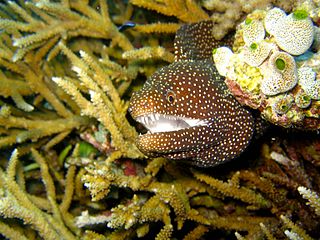
Moray eels, or Muraenidae, are a family of eels whose members are found worldwide. There are approximately 200 species in 15 genera which are almost exclusively marine, but several species are regularly seen in brackish water, and a few are found in fresh water.
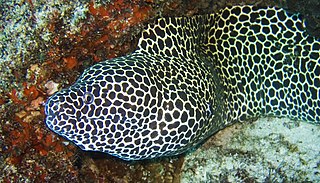
The laced moray, also known as the leopard moray, leopard moray eel, tessellate moray or honeycomb moray, is a species of marine fish in the family Muraenidae.

Gymnothorax is a genus of fish in the family Muraenidae found in Atlantic, Indian and Pacific Ocean. With more than 120 species, it the most speciose genus of moray eels.
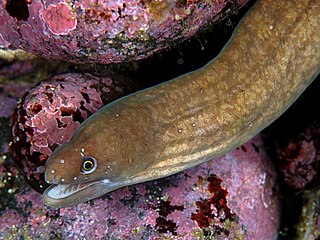
Anarchias is a genus of moray eels in the family Muraenidae.

Uropterygius is a genus of moray eels in the family Muraenidae.

The zebra moray is a species of marine fish in the family Muraenidae. It is the only member of the genus Gymnomuraena, though it sometimes has been included in Echidna instead.
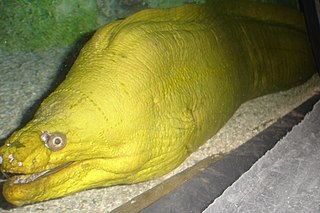
The green moray is a moray eel of the family Muraenidae, found in the western Atlantic Ocean from Long Island, New York, Bermuda, and the northern Gulf of Mexico to Brazil, at depths down to 40 metres (130 ft). Its length is up to 2.5 metres (8.2 ft). It is the largest moray species of the tropical Atlantic and one of the largest species of moray eel known. Though it is not considered endangered, the species is particularly under-studied and estimated to be undercounted by up to 400% in single-pass visual surveys.

The barred moray, also known as the banded moray, the dark-banded eel, the girdled moray, the girdled reef eel, the many banded moray eel, the ringed moray, the ringed reef moray, the striped moray and the zebra eel,) is a moray eel of the family Muraenidae. It was described by John Richardson in 1845, originally under the genus Muraena. It is a marine, tropical eel which is known from the Indo-Pacific, including the Red Sea, East Africa, the Hawaiian Islands, the Marquesan Islands, the Tuamotus Islands, the Ryukyu Islands, and the Great Barrier Reef. It dwells at a depth range of 2 to 20 metres, and leads a benthic lifestyle in reefs and shallow lagoons. Males can reach a maximum total length of 72.3 centimetres (28.5 in).
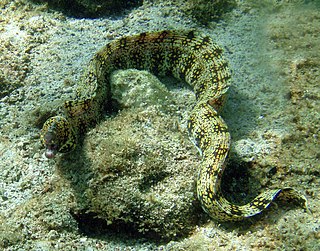
The snowflake moray, also known as the clouded moray among many vernacular names, is a species of marine eel of the family Muraenidae. It has blunt teeth ideal for its diet of crustaceans, a trait it shares with the zebra moray.

The geometric moray is a moray eel of the family Muraenidae found throughout the western Indian Ocean at depths to 40 m. Its length is up to 65 cm. It is parasitized by Ichthyoxenus puhi, a species of isopod.

The giant moray is a species of moray eel and a species of marine fish in the family Muraenidae. In terms of body mass, it is the largest moray eel; however, the slender giant moray is the largest in terms of body length.

The panamic green moray eel is a large moray eel in the Pacific. Common names also include chestnut moray eel.
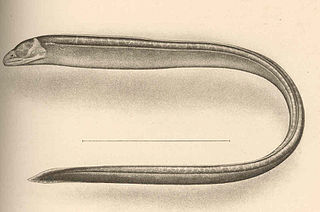
Anarchias leucurus is a moray eel found in the Pacific Ocean. It was first named by Snyder in 1904 as Uropterygius leucurus, and is commonly known as Snyder's moray, the fine-spotted moray or the finespot moray. It is thought to be the smallest species of moray, and may actually represent several different species or subspecies.

Anarchias seychellensis is a moray eel found in coral reefs in the Pacific and Indian Oceans. It was first named by J. L. B. Smith Smith in 1962, and is commonly known as the Seychelles moray or the marbled reef-eel.
Echidna leucotaenia, the whiteface moray, also known as the white-banded moray eel, is a moray eel. It was described by Schultz in 1943. It is a tropical, marine and freshwater eel which is known from the Indo-Pacific, including East Africa, the Line Islands, the Tuamotu Islands, and Johnston Island. It dwells at a depth range of 0 to 24 metres, and leads a benthic lifestyle in reefs. Males can reach a maximum total length of 75 centimetres (30 in).
The mud-dwelling moray, Diaphenchelys pelonates, is an eel of the family Muraenidae, and the only species in the genus Diaphenchelys. It was described by John E. McCosker and John Ernest Randall in 2007. It is a marine, tropical eel which is known from Indonesia, in the western Pacific Ocean. It dwells at a depth range of 15 to 32 metres, and inhabits muddy bottoms, from which its species epithet, "pelonates", is derived. Males can reach a maximum total length of 46.5 centimetres (18.3 in).
The Flores mud moray is an eel in the family Muraenidae. It was described by John E. McCosker and John Ernest Randall in 2008. It is a tropical, marine eel which is known from Indonesia, in the western Pacific Ocean. It is known to dwell at a depth range of 3–4 m. Males can reach a maximum total length of 29.9 cm.
Gymnothorax hansi is an eel in the family Muraenidae. It was described by Phillip C. Heemstra in 2004. It is a tropical, marine eel which is known from reefs around Grand Comoro Island, in the Indian Ocean. It is known to dwell at a maximum depth of 143 m (469 ft).
Anarchias exulatus is an eel in the family Muraenidae. It was described by Joshua S. Reece, David G. Smith, and Erling Holm in 2010. It is a subtropical, marine eel which is known from the Hawaiian Islands, Johnston Atoll, Rapa, Gambier, Pitcairn Island, and the Tonga Islands. It is an uncommon species which dwells in coral reefs and rocky regions near shores, and has been reported at a depth of 12 metres. Males are known to reach a maximum total length of 29.3 centimetres.
Anarchias schultzi is an eel in the family Muraenidae. It was described by Joshua S. Reece, David G. Smith, and Erling Holm in 2010. It is a tropical, marine eel which is known from the western Pacific Ocean, including the Caroline Islands, the Solomon Islands New Caledonia, and the Tonga Islands. It is an uncommon species which dwells at a depth range of 8–14 metres, in coral reefs and rocky regions near shores. Males are known to reach a maximum total length of 15.9 centimetres.












